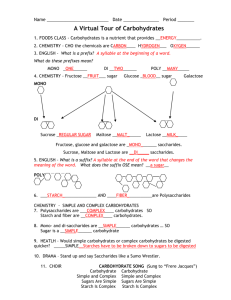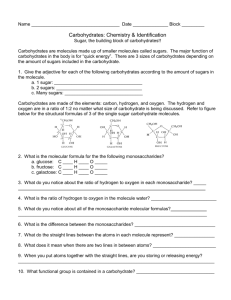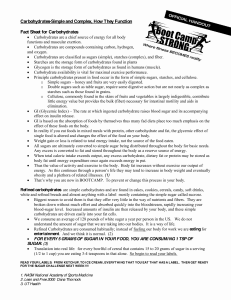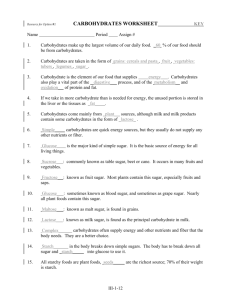What are Carbohydrates
advertisement
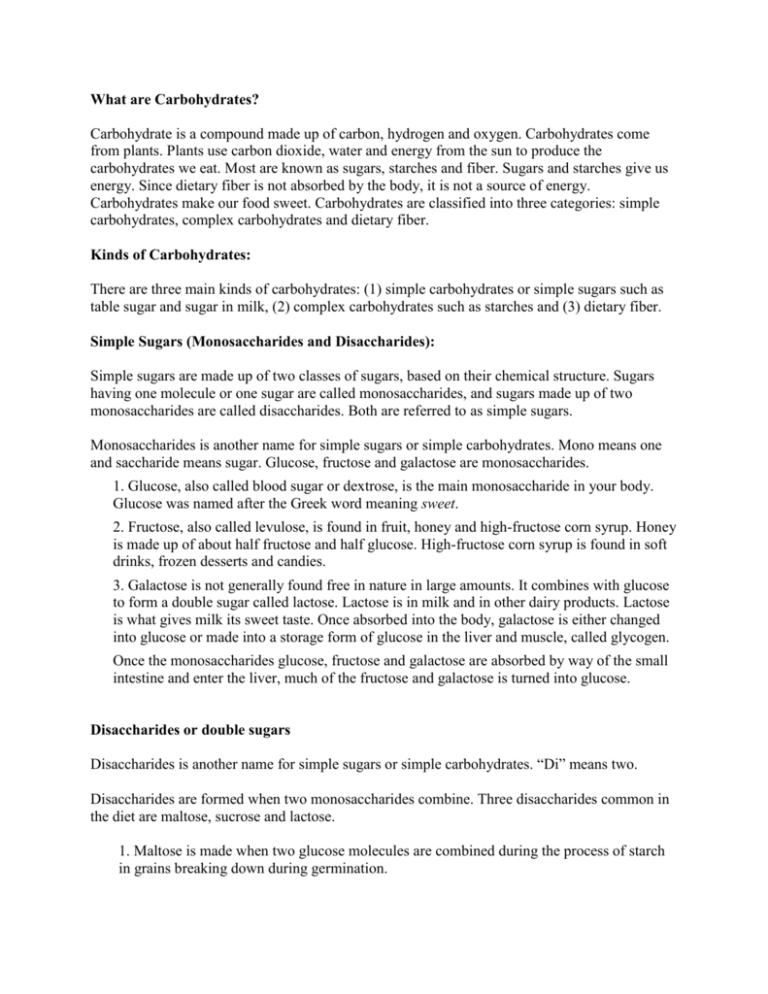
What are Carbohydrates? Carbohydrate is a compound made up of carbon, hydrogen and oxygen. Carbohydrates come from plants. Plants use carbon dioxide, water and energy from the sun to produce the carbohydrates we eat. Most are known as sugars, starches and fiber. Sugars and starches give us energy. Since dietary fiber is not absorbed by the body, it is not a source of energy. Carbohydrates make our food sweet. Carbohydrates are classified into three categories: simple carbohydrates, complex carbohydrates and dietary fiber. Kinds of Carbohydrates: There are three main kinds of carbohydrates: (1) simple carbohydrates or simple sugars such as table sugar and sugar in milk, (2) complex carbohydrates such as starches and (3) dietary fiber. Simple Sugars (Monosaccharides and Disaccharides): Simple sugars are made up of two classes of sugars, based on their chemical structure. Sugars having one molecule or one sugar are called monosaccharides, and sugars made up of two monosaccharides are called disaccharides. Both are referred to as simple sugars. Monosaccharides is another name for simple sugars or simple carbohydrates. Mono means one and saccharide means sugar. Glucose, fructose and galactose are monosaccharides. 1. Glucose, also called blood sugar or dextrose, is the main monosaccharide in your body. Glucose was named after the Greek word meaning sweet. 2. Fructose, also called levulose, is found in fruit, honey and high-fructose corn syrup. Honey is made up of about half fructose and half glucose. High-fructose corn syrup is found in soft drinks, frozen desserts and candies. 3. Galactose is not generally found free in nature in large amounts. It combines with glucose to form a double sugar called lactose. Lactose is in milk and in other dairy products. Lactose is what gives milk its sweet taste. Once absorbed into the body, galactose is either changed into glucose or made into a storage form of glucose in the liver and muscle, called glycogen. Once the monosaccharides glucose, fructose and galactose are absorbed by way of the small intestine and enter the liver, much of the fructose and galactose is turned into glucose. Disaccharides or double sugars Disaccharides is another name for simple sugars or simple carbohydrates. “Di” means two. Disaccharides are formed when two monosaccharides combine. Three disaccharides common in the diet are maltose, sucrose and lactose. 1. Maltose is made when two glucose molecules are combined during the process of starch in grains breaking down during germination. 2. Sucrose or table sugar is made up of glucose and fructose. Sucrose comes from sugarcane, sugar beets, honey and maple syrup. You might use brown, white or powdered sugars in cooking, eating or adding to beverages. These forms of sugar are based on the degree the sucrose is purified from the plant source. 3. Lactose is glucose joined to galactose to form the sugar found in milk and dairy products. Some people are not able to digest large amounts of lactose. This can cause intestinal gas, bloating, cramping and discomfort as any unabsorbed lactose is metabolized by bacteria in the large intestine into acids and gases. Once absorbed into the body, the majority of these carbohydrates are changed into glucose by the liver. Oligosaccharides Oligosaccharides contain three to ten single-sugar units. Oligo means scant. Two of nutritional importance include raffinose and stachyose. These are made of monosaccharides but are bonded together in such a way that the digestive enzymes our bodies make cannot break them down. When we eat these carbohydrates in beans and other legumes, the raffinose and stachyose molecules remain undigested as they reach the large intestine. Bacteria in the large intestine then break them down, producing gas and other byproducts. Polysaccharides (starch and complex carbohydrates) Polysaccharides are composed almost entirely of long strands of only one monosaccharide -glucose. Hundreds of glucose units are connected together to form starch. Starch and complex carbohydrates are the main terms used for the major digestible polysacccarides in our diet. The storage form for carbohydrates in our body is glycogen. When our body needs glucose, the glycogen stored in the liver is turned into blood glucose. Complex Carbohydrates: Also know as polysaccharides (poly = many), these carbohydrates have more than two units of glucose (sugar) linked together. Polysaccharides are generally not sweet and are not water soluble. Starches and dietary fiber are complex carbohydrates. Starch, a complex carbohydrate in potatoes, pasta and rice, is a polysaccharide made up of many hundreds of units of glucose. Fiber is also made up from hundreds of units of glucose. Fiber can be divided into two categories according its physical characteristics and effects on the body: water insoluble and water soluble. Each form functions differently and provides different health benefits. Insoluble fiber, such as cellulose, does not dissolve in water. Insoluble fibers are found in fruits, vegetables, dried beans, wheat bran, seeds, popcorn, brown rice and whole-grain products such as breads, cereals and pasta. Soluble fiber, such as oat bran, dissolves in water. Soluble fibers can be found in fruits such as apples, oranges, pears, peaches and grapes and in vegetables, seeds, oat bran, dried beans, oatmeal, barley and rye. What Carbohydrates Do: Dietary carbohydrates are the main source of energy for the body, including digestion and absorption of other foods. Although proteins and fats can be converted into energy, carbohydrates are the body’s preferred source of energy. Dietary carbohydrates also help in fat metabolism and the formation of nonessential amino acids. In combination with proteins, carbohydrates form substances that are essential to fighting infection, lubricating the joints and maintaining the health and growth of bones, skin, nails, cartilage and tendons. Carbohydrates are components of cell membranes, and they function as antibodies. They form part of cell membranes, particularly in the brain and the nervous system. As an energy source, one gram of carbohydrate yields four calories . Dietary fiber regulates gastrointestinal transit time, and it facilitates efficient elimination. Proper elimination reduces abdominal pressures that can cause hemorrhoids and certain types of hernia. Appendicitis may be associated with inadequate fiber content in the diet, too. A high-fiber diet reduces the rate of colon and rectal cancers by allowing carcinogens in the food to move more quickly through the intestinal tract. Colon cancer might be caused by carcinogens in bile and an increase in anaerobic bacteria, both directly related to high levels of saturated fat and low intake of fiber in the diet. Reducing these chronic diseases can be done by dietary means: reduction of saturated fats and an increase in whole grains, fruits, vegetables and legumes. Recommendations for Carbohydrate and Fiber Intake Of total caloric intake, 45% - 65% should come from carbohydrates. The exact intake in grams will vary, depending on the caloric level of an individual. The Estimated Average Requirement (EAR) for carbohydrate is 130 grams per day for adults and children based on the glucose needs of the brain. The Adequate Intake (AI) for fiber is 14 grams per 1,000 calories consumed (28 grams for 2,000 calories). What Counts as 1 ounce-equivalent from the Grain Group? 1 slice of bread 1 ounce of ready-to-eat cereal 1/2 cup of cooked cereal, rice or pasta Easy Ways to Get More Carbs Carbohydrates from fruits, vegetables and grains should be the bulk of calories. For optimal health, foods such as whole-wheat bread, brown rice, whole-grain pasta are the best choices. Not only will these foods help protect against a range of chronic diseases; they add variety to the diet. Use these suggestions to add carbohydrates to your diet: 1. Join the breakfast club. Choose from many convenient choices such as cereal, English muffins, bagels, waffles, pancakes and toast. Choose whole wheat! 2. Get cracking. Keep a box of crackers or pretzels and some fruit around to curb hunger pangs with carbs. 3. Bag it. Put dry cereal in a plastic bag and take it along for a quick snack or breakfast on the run. Eat it plain or mix with yogurt or skim milk if kept cold. 4. Curl up with a tortilla. Toss low-fat cheese on a tortilla and pop it in the microwave for a few seconds. Roll it up and dip it in salsa for a healthy, fast snack. Or, spread a tortilla with low-fat peanut butter and jelly and roll it. 5. Satisfy your sweet tooth with tasty carbs. Try angel food cake, fig bar cookies, animal crackers and graham crackers. 6. Bag up mini-bagels for an energy-rich snack to eat on the run. 7. Use whole-grain breads for lunch or snacks. 8. Try low-fat granola-type cereals as a topper for fruit-flavored or frozen yogurt. 9. Try whole-wheat pasta. Diets high in complex carbohydrates are healthier than the high-fat diets many of us are eating. The United States Department of Agriculture (USDA) recommends that 45% - 65% of total calories for the day should come from carbohydrates Questions See if you know the answers to these questions and write them down: 1. Some of the different kinds of sugars end with the same three letters. What are these three letters? 2. List the names of the different kinds of sugars that end with these three letters. 3. If you look at a list of ingredients on a food label, what word ending with these three letters would tell you that that ingredient is sugar? 4. Which foods are sources of fructose and galactose? All starchy foods are plant foods. Major food sources of starch include grains, legumes (beans and peas), potatoes and sweet potatoes. Other good carbohydrate foods include pastas and vegetables. When you eat these starchy foods, enzymes in your mouth and intestine hydrolyze or break down the starch molecule to release glucose units and water, which are absorbed across the intestinal wall into the blood. One to four hours after a meal, all the starch has been digested and is circulating to the cells as glucose. Foods that are complex carbohydrates are also some of our least expensive foods! We need to reduce our intake of concentrated sweets and food or beverages with a lot of sugar added. These include sweets and beverages that have little or no nutritive value and give primarily calories. Instead, we need to eat more complex carbohydrates such as grains, legumes, potatoes and other vegetables and pasta and eat more naturally occurring sugars (fruits, vegetables and milk). Read the Nutrition Facts label on food packages. Look to see what percentage of calories from carbohydrate the food provides. The percentage of calories from carbohydrate is more important than the total grams of carbohydrate in a particular food. The carbohydrate content of foods can be diluted either by protein, as the case in skim milk, or by fat, as in a cream pie. Select a nutrient-dense carbohydrate food to get more nutrition bang for the buck. Carbohydrates and the Nutrition Facts Labels Carbohydrate is required on the nutrition facts label. It is listed first as total carbohydrate with the total amount of carbohydrates given in grams (g). The Daily Reference Value (DRV) for total carbohydrate is 300 grams (based on 60 percent of a 2,000 calorie reference diet). Carbohydrates are then broken down into three types: dietary fiber, sugars and other carbohydrate. Other carbohydrate refers to complex carbohydrates or starches. Sugars are required on the nutrition label. Carbohydrate and Sugars Label Claims Sugar Free - Less than 0.5 g sugar/serving Reduced Sugar - At least 25 % less sugar than the regular product No Added Sugars, Without Added Sugar, No Sugar Added 1. No amount of sugars, or any ingredient that contains sugars that functionally substitute for added sugars, is added during processing or packaging 2. Contains no ingredients that contain added sugars, such as jam, jelly or concentrated fruit juice 3. The label specifies that the food is not low calorie or calorie reduced as appropriate. Monosaccharides and disaccharides are often referred to as simple sugars. Food labels sometimes lump all these sugars under that one category, listing them as sucrose and other sugars. The nutrition label on a food package does not list a Percent Daily Value (% Daily Value) for sugars. There is no scientific proof to indicate that a particular amount of sugars in the diet is appropriate or inappropriate. Other than dental caries or cavities, there is no evidence that sugar intake is associated with chronic disease conditions. The ingredient list tells you exactly what is in a food. Ingredients are listed by weight from most to least. Those in the largest amounts are listed first. Ingredients that are sugars may be listed as different words. Many of these end with three letters: ose. These include lactose, maltose, glucose, sucrose, fructose, dextrose, polydextrose and levulose. Other names of sugars used in foods include brown sugar, confectioner’s sugar, turbinado sugar, invert sugar, sorbitol, mannitol, honey, corn syrup or sweeteners, high-fructose corn syrup, molasses, date sugar, maple syrup, dextrin, caramel and fruit sugar. Activity Get two boxes of cereal and compare the breakdown of the total carbohydrate they contain. How many grams of dietary fiber, sugars and other carbohydrates do they provide? Which is lowest in sugar? Now, look at the list of ingredients. When does a source of sugar appear in the list of ingredients? Is it listed first, second, third or later in the listing? Ingredients in largest amounts are listed first. For the highest nutritive value, select the cereal that is high in other carbohydrate, high in dietary fiber and lower in sugars. For more nutritive value, select a cereal that does not give a source of sugar as the first, second or perhaps even the third item listed in the list of ingredients. Use this information to help you make informed choices. Did you know? Fewer than one in 10 Americans eats the recommended amount of food from the Grain Group. In 1996, bread, buns and rolls topped the list for the most foods eaten from the Grain Group. Americans eat an all-time high of 25 pounds of candy a year! It's not just children eating candy. More adults are celebrating Halloween, and older adults eat candy to remind themselves of memories of when they were young. Americans spent nearly $1.8 billion on Halloween candy in 1998. When Americans were asked to name their three favorite foods from the Grain Group, bread was ranked first, followed by cereal, rice and pasta. Although foods from the Grain Group are good buys, Americans spend only 15 cents of their food dollars on those foods. They spend 16 cents of their food dollars on fruits and vegetables. Almost 60 cents of the food dollar is spent on more expensive food, including foods that are high in fat or sugar. Of this 60 cents, 30 cents is spent on other foods, foods that generally are high in fat or sugar and are more expensive, and 27 cents is spent on foods from the Meat, Poultry, Fish and Eggs Food Group. Americans get most of their saturated fat, the unhealthy kind, from this food group by not selecting lower-fat choices. Popular Diets A number of popular diets are low in carbohydrates. Some suggest that carbohydrates are “bad” and unnecessary; others emphasize high carbohydrate intake. High Carbohydrate/Low Fat (Ornish, Pritikin and Food for Life diets) Thousands of “low-fat” alternatives now crowd the supermarket shelves. But simply cutting back on fat and loading up on carbohydrates may not be a healthy way to eat or lose weight, according to research. Just as not all types of fat are bad, not all types of carbohydrates are good. Gram for gram, fat has more than twice as many calories as either protein or carbohydrates. Yet all too often the low-fat products on supermarket shelves are packed with sugar and highly processed carbohydrates to make up for the taste that’s lost when fat is removed. These low-fat alternatives often have just as many calories as the full-fat versions and may even have more. Low Carbohydrate/High Protein (The Zone, Atkins, South Beach) In theory, a high-protein/low carbohydrate diet could help increase satiety, the feeling of fullness that comes with eating. Fewer carbohydrates could also avoid fast and high rises, and falls, in blood sugar, which may also keep hunger at bay. Together, these could help avoid overeating and make one satisfied with fewer calories. In a review of low-carbohydrate diets, it was shown that low-carbohydrate diets were safe in the short term but that weight loss was due mostly to reduced caloric intake, not necessarily to the low-carbohydrate nature of the diets. Such reductions often happen when people drastically change what they eat. Until more is known about diets that manipulate macronutrient ratios, it is best to follow the USDA’s 2005 Dietary Guidelines for any diet, whether reduced-calorie or not. Artificial Sweeteners Saccharin (Sweet ’n Low)– provides no calories and is 200 times sweeter than sugar. It was banned by the FDA until consumers rallied in support. Today a statement has to be added to foods that have saccharin that states that it can cause cancer in laboratory animals. Aspartame (Equal) – composed of two amino acids and provides 1 calorie/tsp. It is 180-220 times sweeter than sugar. Aspartame may cause headaches in sensitive individuals. Heat denatures aspartame, and therefore it cannot be used in foods that need to be cooked. Acesulfame K – provides no calories and is about 200 times sweeter than sugar. It is heat stable and can be used in foods that need to be cooked or heated. Sucralose (Splenda)– a fairly new product derived from table sugar. It is 600 times sweeter than sugar and is stable at high temperatures. Summary Choose a diet with plenty of grain products, vegetables and fruits. They give you carbohydrates, a nutrient that gives you get up and go! Carbohydrate foods are also generally low in fat, depending on how they are prepared and what is added to them at the table. Follow the Dietary Guidelines and MyPyramid to eat healthy and stay healthy every day. To fuel up on carbs, have 6 ounce-equivalents from the Grain Group, 2.5 cups from the Vegetable Group and 2 cups from the fruit group every day (for a 2,000 - calorie diet). For other important nutrients, eat 3 cups from the Milk Group and 5 ounce-equivalents from the Meat Group. Since dry beans are a good source of protein, they are found in the meat group as well as in the vegetable group. Foods that are complex carbohydrates are also some of our least expensive foods! Major food sources include grains, legumes (beans and peas), potatoes and sweet potatoes. For more nutritive value, eat more naturally occurring sugars that are in fruits, vegetables and milk instead of concentrated sugars in candy, cookies and soft drinks. Read the Nutrition Facts label on food packages. Look to see what percentage of calories from carbohydrate the food provides. The percentage of calories from carbohydrate is more important than the total grams of carbohydrate in a particular food.
